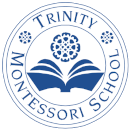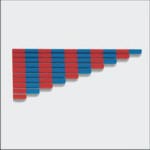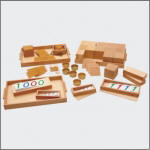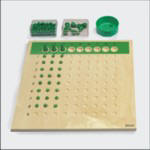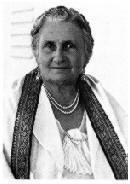
Dr. Maria Montessori studied young children in Italy in the early 1900s and observed that a child has an innate desire to learn and is essentially a sensorial explorer within his or her environment. From her research, Dr. Montessori developed a child-centered curriculum that is now implemented and celebrated around the world.
“Montessori” has come to mean education for life that evolves from a child’s use of all his or her senses in the learning process. Designed for manipulation and experimentation, various Montessori materials and apparatuses promote independence and creativity. Specially designed tools allow the child to proceed at his or her own pace, from dressing himself or herself at age three, reading at age four to working on computer at age five.
The late Helen Keller, a deaf-blind American author, activist and lecturer, was inspired by Dr. Montessori and once wrote “Children will educate themselves under the right conditions. They require guidance and sympathy far more than instruction.” This represents a succinct summary of the Montessori method of education.
The Montessori Teacher
The role of a Montessori teacher is one of guide and observer, whose ultimate goal is to encourage independent work and exploration with the materials and to intervene less and less as the child develops. The teacher strives to build an atmosphere of calm, order and joy in the classroom, to encourage and recognize the children in all their efforts and to promote self-confidence and discipline.
When working with the younger students at each level, the teacher is more active and often demonstrates the use of materials and presents activities based on an assessment of each student’s needs. Knowing when to observe and how much to intervene is a skill the Montessori teacher must develop and hone through professional training and work experience.
The Montessori Approach
The Montessori approach offers a broad vision of education as an aid to life and aims to help children with their task of finding and developing the individual within as they grow from childhood to maturity. This approach is effective because it draws its principles from the natural development of the child and its inherent flexibility allows the method to adapt to the particular needs of the individual, regardless of the level of ability, learning style, or social maturity.
A Montessori classroom is a carefully designed and prepared space that offers the children an environment in which they are free to respond to their natural drive to work and learn. The children’s innate love of learning is encouraged by giving them opportunities and resources to engage in spontaneous, meaningful activities under the guidance of a Montessori teacher. Through their work, the children develop concentration, motivation, persistence and discipline, which qualities will help the children to succeed in future schooling and careers.
Areas of Study
Practical Life
The practical life section is the most important area of study of a Montessori education. It is through these materials that the child develops the self-confidence, control and concentration essential for mastery of the other more advanced areas of study such as language and mathematics.
Children are naturally drawn to this area because these materials are most familiar to them. This familiarity also serves to provide the children with a feeling of security and well-being. The activities will contain objects and materials that are normally encountered in the everyday living experiences of the children’s culture. Many of them are fundamental activities that children need to master to be able to live comfortably in the real adult world. Most of the activities of practical life will fall into four main categories: grace and courtesy, care of self, control of movement, and care of the environment.
Primary purposes of practical life activities include:
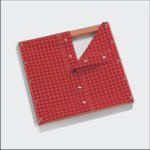
· To develop and perfect muscle control and coordination through organization of movement.
· To develop a sense of physical and mental order through exactness in use of objects and working in definite sequence.
· To develop understanding through control of the environment resulting in a sense of dignity and self-confidence, joy in completing tasks, and social maturation among children.
· To develop concentration and persistence through focusing of attention on work, thus fostering independence and self-reliance.
· To develop respect, discipline and self-control through enforcement of established classroom rules and procedures.
Sensorial
In the words of the child:
“I Hear and I forget,
I See and I remember,
I Do and I understand.”
Dr. M. Montessori
The sensorial materials help the child to become aware of detail. Each of the activities isolate one defining quality, such as color, weight, shape, texture, size, sound and smell. The primary purpose of these activities is to help the child in his/her effort to sort out the many and varied impressions collected by the senses. Each apparatus for the sensorial activities consists of a set of objects which, experienced together, evidence a single perceptual quality, such as ‘colour’ or ‘taste’. This experience of a single quality occurs because each object in the set is identical in all respects except that one quality.
Listed below are some of the Sensorial activities for each of the following sense faculty:
The visual sense (which perceives size, shape, composition, pattern and colour): Cylinder Blocks (alas Knobless Cylinders), Pink Tower, Brown Stairs, Red Rods, Colour Tablets, Geometric Cabinet, Constructive Triangles, Square of Pythagoras, Binomial and Trinomial Cubes.
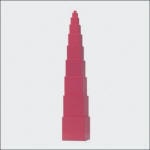
The tactile sense (perceiving texture): Touch Boards, Tactile Tablets, Fabrics.
The baric sense (perceiving weight): Baric Tablets.
The auditory sense (perceiving loudness and pitch): Sound Boxes, Bells, Tonebars.
The gustatory sense (perceiving tastes): Tasting Cups.
The olfactory sense (perceiving scents and odours): Smelling Boxes.
The stereognostic sense (which perceives through tactile and muscular impression, combined with movement): Geometric Solids, Stereognostic Bags, Mystery Bag, Sorting Grains.
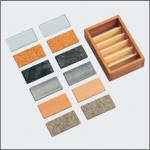
The thermic sense (perceiving temperature and heat absorption potential): Thermic Bottles,Thermic Tablets.
It is in the sensorial area that math concepts are first introduced and internalized. The sensorial activities provide the child with basic skills needed for mathematics work, including, calculation of amount or degree, exactness in perception and dexterity, discrimination among similarities, repetition, set recognition, algebraic analysis, and recognition of progression in a series. Most of the sensorial materials provide the child with experiences in more than one of these skills.
Activities in this area also indirectly prepare the child for writing and reading. For example, through the manipulation of the Cylinder Blocks, the child develops the muscles in his fingers as well as his coordination, which are critical for proper pencil grip and manipulation. Through the use of the rough and smooth boards, the child develops light touch for writing. The child also becomes familiar with the shape and curves of letters in writing through learning the different shapes in Geometrical Cabinet.
Language
The development of language in early-childhood classrooms is an umbrella for the entire Montessori curriculum. Language learning occurs most profoundly in the moment-to-moment interactions amongst students and teachers within the classroom. Children learn to listen, speak, and later to write and read through the multitude of materials and activities within the language area of a Montessori classroom. These activities provide opportunities for young children to expand vocabulary, listen carefully to common sounds, and look carefully to find likenesses and differences among objects and pictures. Matching sets of objects, learning the names of household items, unusual animals and insects and geometric shapes are just some of the activities which build language and early literacy skills and will be found in a Montessori classroom. Dr. Maria Montessori personally developed only three language materials for the early childhood classroom: the metal insets, the sandpaper letters and the moveable alphabet. These materials have proven to be astoundingly effective.
Language is divided into three areas: speaking, writing and reading. Speech develops naturally in a child. From 2 to 6 years of age, the child is at his sensitive period for language and is said to have an “absorbent mind”. While the child retains many of the sounds he/she hears, the information is stored randomly in different places in the mind. Typically around the age of 2 ½, an explosion of actual speech and language in the child’s mother tongue take place. The child starts to speak in complete sentences and begins to grasp complete thoughts communicated to him or her. Therefore, at this stage, it is important to provide the child with all the correct information (e.g. correct diction and proper grammar) to allow him or her to pick up and assimilate and to build a solid foundation in language. Classified picture cards, stories and poetry are some of the materials used to help enrich the children’s vocabulary.
Since speech develops naturally in a child, Montessori language activities therefore presume that the child will spontaneously begin to speak with meaning, and the purpose of the language activities is largely to cultivate reading and writing. This begins with phonetic introduction of the alphabet with the use of the Sandpaper Letters (see photo).
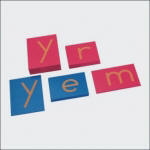
“Phonetic” means by sound and the Montessori reading program is based on the sounds (as opposed to the names) associated with the letters of the alphabet. The child move progressively from single sound of single letters (e.g. “s”) to more complicated sound of a group or combination of letters which are called “phonograms” (e.g. “sh” or “qu”) with the use of phonogram materials. A phonetic word is a word that the child can read by pronouncing the sound of each letter the way he was taught using the sandpaper letters. All other words are called “non-phonetic” words. Only words with short vowels can be called “phonetic”. Example of phonetic words: man, bed, milk, frog, jug, .
Once the child has learned the phonetic sounds of a few vowels and about half of the consonants, the child will start “word building” with the Movable Alphabets and will soon begin to read. The first level in the reading scheme is called “Pink Scheme”, representing reading of phonetic words with three letters or less. The next level is “Blue Scheme”, representing reading of phonetic words with four or more letters. The last level is “Green Scheme”, representing reading of words with phonograms. It is recommended that a child receives 3 years of Montessori education in the Casa level, during which the child will move through an extensive series of exercises and explore all facets of the English language including grammar and syntax.
Mathematics
Montessori students use a variety of hands-on learning materials that make abstract concepts clear and help the child to develop a sound foundation in mathematics and geometry.
By using concrete materials during the early years, the child can learn the basic concepts of mathematics and the relationship between numbers and quantities.
Mathematics activities are organized into five groups: (1) introduction to numbers; (2) introduction to the Decimal System; (3) introduction to tens, teens and counting; (4) arithmetic tables; and (5) abstraction.
The activities within each group are as follows:
Culture
In the culture area, the students work with nomenclature, proper terminologies, definitions and scientific knowledge, and these are coupled with the reading and writing curriculum to give the child a practical extension of skills in language and literacy.
Cultural activities include music, physical education, basic science, Geography, Zoology, Botany (study of plants) and art, all which are taught at a sensorial level.
Social Studies:

Montessori preschools offer many opportunities for the child to expand knowledge of the world during the early years when they are motivated by spontaneous interest. The materials provided in the social studies area spark this interest. Some of the materials in this area are: Land and Water Globe, Continent Globe (shown), World Map Puzzle, picture packets of animals and people in other countries and career exploration.
The classroom offers children a concrete representation of history by letting them work timelines. Some examples of study through the use of timelines are: prehistoric life, presidents, the student’s own life timeline or the teacher’s life timeline and the child’s day. Other cultures as well as our own are explored. Important figures from the past are discussed.
Geography
The children learn about the world around them through various Montessori materials. The use of puzzle maps, atlas’ and globes to name a few, allows the child to learn, depending upon their age, many different aspects of a continent or the name of a particular country, it’s flag, the capital city, population, terrain native to a particular country, import/export, animals (land, air and ocean) etc. They are introduced to land and water formations, space, weather, explorers and many other facts about the world we live in, both past and present and possibly what the future may hold in the way of technology, science and human potential.
Basic Science
Science is an integral element of the Montessori curriculum. The program is designed to cultivate the child’s curiosity and determination to discover the truth for themselves. They learn how to observe patiently, analyze, and work at each problem. Students engage in field trips and hands-on experiments and typically respond with enthusiasm to the process of carefully measuring, gathering data, classifying and predicting the outcome. One goal of Montessori science is to cultivate a lifelong interest in observing nature and discovering more about the world in which we live. Some science activities you could see in a Montessori classroom are activities of magnetism, weights, growing plants and classification of plants and animals.
The children’s natural curiosity is stimulated through discovery projects and experiments which help the children to draw their own conclusions and formulate their own hypothesis. The plant and animal kingdoms are studied in an orderly fashion to foster a love and appreciation for all living things.
Biology
The biology curriculum is a natural extension of the care and maintenance of the classroom pets as well as the plants and the natural environment that are a part of our world both indoor and out. Biology also extends out into our geography curriculum as we study the biomes of the earth and the flora and fauna that exist in all of these different place on our planet.
Botany
This program follows the concept of “Earth Kinder”, a Montessori philosophy that emphasizes the natural processes and harmonious living on our planet. Children are introduced to plants, water, the sun and learn about the delicate balance of our ecosystem and how it affects their everyday life.
Zoology
Zoology is studied in-depth and introduces the child to animals and their needs, characteristics and habits. Children are always fascinated with animals whether they are learning about animals that live in the wild, pets, marine life or dinosaurs.
History
Through daily calendar tell exercises, time lines and occasional birthday celebration, the children develop a sense of time and history. The clock and to tell time is also introduced as part of history and math activity.
Conclusion:
Because children learn more readily when they are self-directed, and because the learning environment is so rich, our students can progress quickly in their academic learning. Most five-year-olds in their third year are reading, writing, doing decimal math, science experiments, understand world culture and geography and are beginning to gain a global view of earth’s history.

